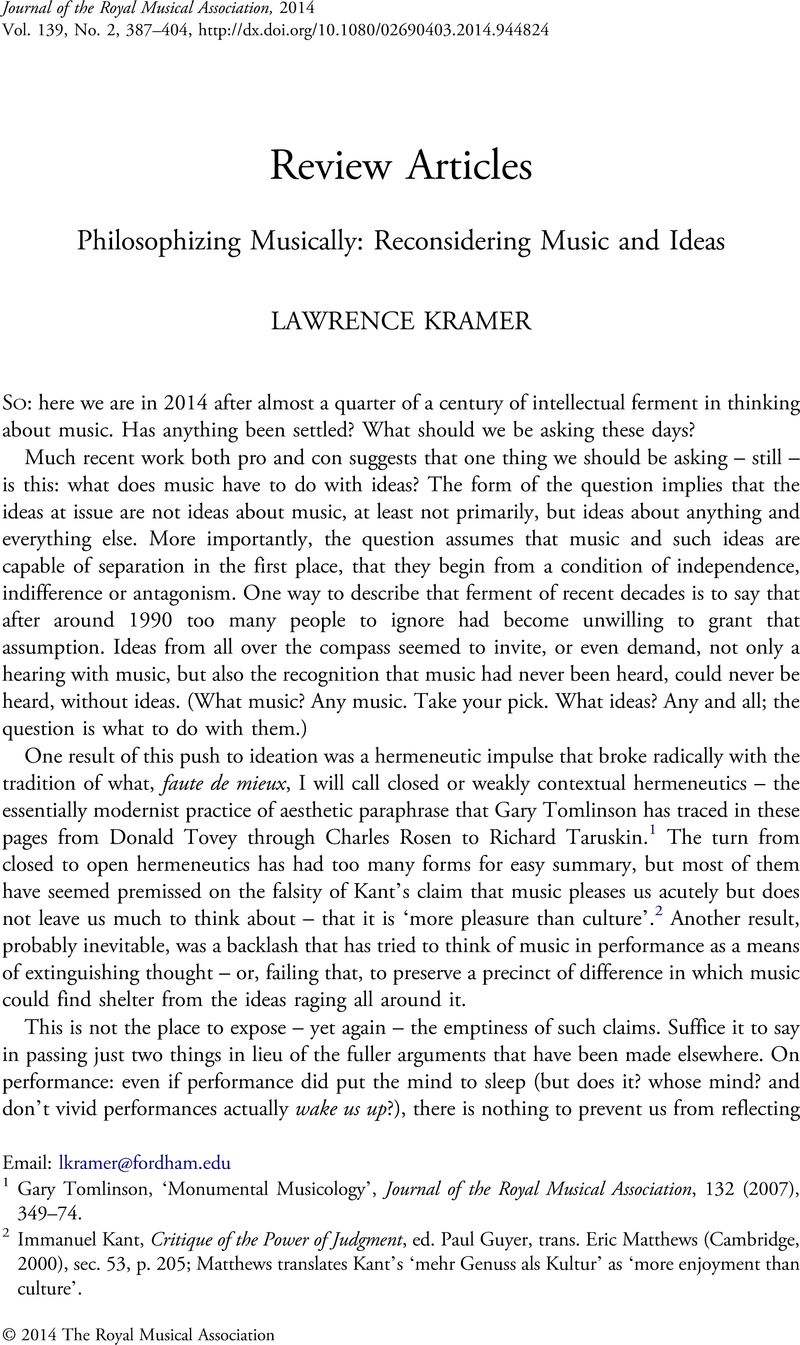Published online by Cambridge University Press: 01 January 2014

1 Gary Tomlinson, ‘Monumental Musicology’, Journal of the Royal Musical Association, 132 (2007), 349–74.
2 Immanuel Kant, Critique of the Power of Judgment, ed. Paul Guyer, trans. Eric Matthews (Cambridge, 2000), sec. 53, p. 205; Matthews translates Kant's ‘mehr Genuss als Kultur’ as ‘more enjoyment than culture’.
3 James Currie, ‘Music After All’, Journal of the American Musicological Society, 62 (2009), 145–203.
4 J. W. T. Mitchell, Picture Theory: Essays on Verbal and Visual Representation (Chicago, IL, 1995), 151–65. On the role of ekphrastic hope and fear in descriptions of music, see my Musical Meaning: Toward a Critical History (Berkeley, CA, 2002), 11–28.
5 J. P. E. Harper-Scott, The Quilting Points of Musical Modernism: Revolution, Reaction, and William Walton (Cambridge, 2012).
6 Jacques Lacan, Seminar XVII: The Other Side of Psychoanalysis, ed. Jacques-Alain Miller, trans. Russell Grigg (New York, 2007), 11–28.
7 See my Expression and Truth: On the Music of Knowledge (Berkeley, CA, 2012), 89–90, 133, 148.
8 Walter Benjamin, Illuminations: Essays and Reflections, trans. Harry Zohn (New York, 1968), 120.
9 Benjamin, Illuminations, 144.
10 Suzanne Langer, Philosophy in a New Key: A Study in the Symbolism of Reason, Rite and Art (New York, 1962), 204.
11 Andrew Bowie, Music, Philosophy, and Modernity (Cambridge, 2007), 10–12.
12 Lacan, Seminar III: The Psychoses, ed. Jacques-Alain Miller, trans. Russell Grigg (New York, 1993), 258–70 (p. 268).
13 Alain Badiou, Being and Event, trans. Oliver Feltham (New York, 2005), 55. Again: ‘If the void is thematized, it must be according to the presentation of its errancy, and not in regard to some singularity, necessarily full, which would distinguish it as one within a differentiating count. […] The void is thus distributed everywhere. […] The void, in a situation, is the unpresentable of presentation’ (Alain Badiou, Being and Event, trans. Oliver Feltham (New York, 2005), 57).
14 In view of the statement quoted in the previous footnote, one might argue that the C♯ in the ‘Eroica’ is not eligible to be the void element; the void would instead be a condition not describable in the technical vocabulary of music and not achievable until the movement, or the whole symphony, has run its course. But to say so sounds, to my ear, fussy and dogmatizing. There is as much or more to be gained from countering or reframing this – or any – idea as there is from adhering to it. We have to interpret what we hear, or can hear, and if the results run counter to the idea, so much the worse for the idea. Beethoven, we might say, owes no allegiance to Badiou. His C♯, above all in performance, thematizes itself as a wandering fullness and dares us to hear or play it any other way.
15 The song may also have more than just one void element. The famous beginning with birds and bees was an afterthought; the original lyrics began with some epithets referring to racial others who ‘do it’, a device that Porter withdrew but that echoes in several of the lyrics he kept, for example in the early reference to the somewhat exotic ‘Lithuanians and Letts’ (Latvians, with a pun on ‘Let's’). The song's act of subtraction may thus include racially marked pleasures denied to normative Western whites, regardless of (or because of) their social and economic dominance – pleasures that may themselves be a stand-in for the then-outlawed pleasures of Porter's homosexuality.
16 Martin Heidegger, Poetry Language Thought, trans. Albert Hofstadter (New York, 1971), 180.
17 See my Interpreting Music (Berkeley, CA, 2010) and Expression and Truth.
18 On the performative effects of shifters, see Susan Stewart, Poetry and the Fate of the Senses (Chicago, IL, 2002), 46, 150–2.
19 Alfred North Whitehead, Science and the Modern World (1925; repr. Cambridge, 2011), 64–72. One cautionary note: it is important not to confuse singularity with rarity or unusualness. My approach to this question has sometimes been misunderstood (for example by Holly Watkins in her review of Musical Meaning and Human Values, a volume edited by Keith Chapin and myself, in Music Analysis, 31 (2012), 259–71). The judgment that something is unusual may be useful or pertinent in certain circumstances, but in itself it settles nothing. Singularity comes not from what something is but from how it is. Black swans are unusual but not for that reason singular; the white swans (real or fictitious) described in Yeats's poem ‘The Wild Swans at Coole’ are singular, even though they are perfectly ordinary birds. Beethoven's ‘Funeral March’ Piano Sonata (no. 12 in A♭, op. 26) is unusual because none of its four movements is in sonata form, but what makes it singular is, among other things (singularities have plural sources), its refusal (or rather the details of its refusal) of the affirmative narrative arc of another, larger work, also with a funeral march, that it anticipates: the ‘Eroica’ Symphony. For more on the Beethoven, see my ‘Speaking of Music’, Speaking of Music: Addressing the Sonorous, ed. Andrew Clark and Keith Chapin (New York, 2013), 26–34.
20 Jean-Luc Nancy, Listening, trans. Charlotte Mandell (New York, 2007), 39–40.
21 ‘The judgment of taste differs from logical judgment in that the latter subsumes representation under a concept of the object, but the former does not subsume under a concept at all, for otherwise the necessary universal approval could be compelled by proofs. All the same, however, it is similar to the latter in that it professes a universality and necessity, albeit […] grounded only on the subjective formal condition of judgment in general’; Kant, Critique of the Power of Judgment, ed. Guyer, trans. Matthews, sec. 35, p. 167.
22 Maurice Merleau-Ponty, Phenomenology of Perception, trans. Donald A. Landes (New York, 2013), 232–9.
23 See pp. 60–1, 72, 155–7; ‘everyday enchantment’ in the present text condenses several different formulations.